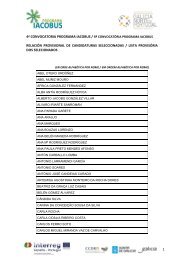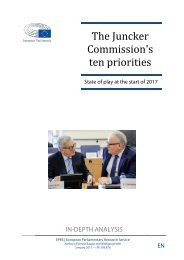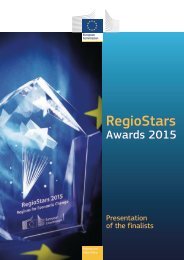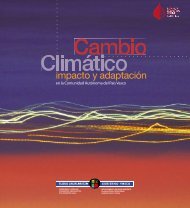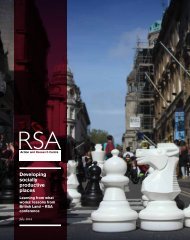1euaGiT
1euaGiT
1euaGiT
You also want an ePaper? Increase the reach of your titles
YUMPU automatically turns print PDFs into web optimized ePapers that Google loves.
In 2001 the European Commission’s White Paper on Youth 29 defined a framework for<br />
cooperation in the youth field and the open method of coordination was adapted to the<br />
youth sector. In terms of policy priorities, the white paper emphasised fostering<br />
information, participation, voluntary activities and a greater understanding of youth.<br />
The White Paper was the basis for national youth policies right across the Member<br />
States.<br />
Besides the Youth open method of coordination, the European Youth Pact was adopted<br />
by the European Council in March 2005 as one of the instruments to achieve the revised<br />
Lisbon objectives, promoting growth and more and better jobs. Its aim was to improve<br />
education, training, mobility, employment and social inclusion of young people, whilst<br />
helping to achieve a work-life balance.<br />
By 2007 the European Commission launched the Youth in Action programme, a specific<br />
programme set up for young people in the EU. The programme funds mobility and nonformal<br />
education activities such as youth exchanges or EVS (European Voluntary<br />
Service) which target young people.<br />
Starting at the end of 2008, Europe was thrown into an economic crisis and as a result<br />
faces a range of economic and social inclusion related challenges, affecting young<br />
people in particular. Therefore, young people are a priority at EU level as the crisis<br />
reinforces the need to invest in young human capital. With this in mind, the Council of<br />
Youth Ministers adopted the EU Youth Strategy for 2010-2018, which is about providing<br />
opportunities for young people who are in education and on the labour market, and<br />
promoting active citizenship and social inclusion for youth. Young people are consulted<br />
through the structured dialogue process, an essential component of the EU Youth<br />
Strategy.<br />
In 2010 the EU developed a new plan of action to not only overcome the crisis, but to<br />
also put in place a strategy to create a growth model that is smart, sustainable and<br />
inclusive. Whilst young people are crucial to achieving those objectives and are high on<br />
the agenda of the Europe 2020 strategy, it is also young people who have suffered the<br />
consequences of the crisis in terms of unemployment, migration and of course changed<br />
expectations for their futures. As the Council Recommendation on establishing a Youth<br />
Guarantee 30 states, young people ‘are vulnerable because of the transitionary life period<br />
they are going through, their lack of professional experience, their sometimes<br />
inadequate education or training, their often limited social protection coverage,<br />
restricted access to financial resources, and precarious work conditions’.<br />
Young people face many challenges in the EU of today:<br />
■ The unemployment rate amongst young people in the European Union 31 is dangerously<br />
close to being one in four. This equates to more than 5.5 million young people across<br />
Member States.<br />
■<br />
Unemployment amongst the under 25s has risen by 6 % since 2007, this means there is<br />
almost an additional 1.4 million young people who are unemployed today compared to<br />
before the economic crisis.<br />
29 European Commission (2001) European Commission White Paper: A new impetus for<br />
European Youth.<br />
30 Council Recommendation of 22 April 2013 on establishing a Youth Guarantee, [online]<br />
Available at: < .http://eurlex.europa.eu/LexUriServ/LexUriServ.douri=OJ:C:2013:120:0001:0006:EN:PDF>.<br />
31 Eurostat unemployment rate – annual average in % for 2012 under 25 years old for<br />
the EU 27 was 22.8 %.<br />
41



